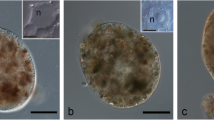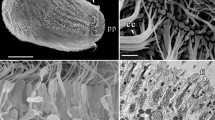Summary
The gray cells of four orders of demosponges contain basophilic inclusions and glycogen. They are capable of synthesis and accumulation of glycogen and responsible for its transfer to sites of more intense metabolism (growth, bud, blastema). They do not occur in larvae; but all the phases of their differentiation from the flagellar cells of the larva have been demonstrated.
Similar content being viewed by others
References
Borojević, R.: Etude du développement et de la différenciation cellulaire d'éponges calcaires calcinéennes (genres Clathrina et Ascandra). Ann. Emb. Morphogen. 2, 15–36 (1969)
Borojević, R.: Différenciation cellulaire dans l'embryogénèse et la morphogénèse chez les Spongiaires. Symp. zool. Soc. Lond. 25, 467–490 (1970)
Borojević, R., Fry, W.G., Jones, W.C., Lévi, C., Rasmont, R., Sarà, M., Vacelet, J.: Mise au point actuelle de la terminologie des éponges, Bull. Mus. natn. Hist. nat. Paris 35, 1224–1235 (1967)
Borojević, R., Lévi, C.: Etude au microscope électronique des cellules de l'éponge: Ophlitaspongia seriata (Grant) au cours de la réorganisation après dissociation. Z. Zellforsch. 64, 708–725 (1964)
Borojević, R., Lévi, C.: Morphogénèse expérimentale d'une éponge à partir de cellules de la larve nageante dissociée. Z. Zellforsch. 68, 57–69 (1965)
Boury-Esnault, N.: Une structure inhalante remarquable des Spongiaires: le crible — étude morphologique et cytologique. Arch. Zool. exp. gén. 113, 7–23 (1972)
Boury-Esnault, N.: Structure et ultrastructure des papilles d'Eponges du genre Polymastia Bowerbank. Arch. Zool. exp. gén. 115, 141–165 (1974)
Boury-Esnault, N.: Ultrastructure de la larve parenchymella d'Hamigera hamigera (Schmidt) Démosponge, Poecilosclerida). Origine des cellules grises. Cah. Biol. mar. 17, 9–20 (1976a)
Boury-Esnault, N.: Morphogénèse expérimentale des papilles inhalantes de l'éponge Polymastia mamillaris (Müller). Arch. Zool. exp. gén. 117, 181–196 (1976b)
Connes, R.: Etude histologique, cytologique et expérimentale de la régénération et de la reproduction asexuée chez Tethya lyncurium (= T. aurantium Pallas) (Démosponge). Thèse Doctorat d'Etat -Montpellier-n∘ AO 2746 CNRS (1968)
Connes, R., Diaz, J.P., Paris, J.: Variations saisonnières des populations cellulaires de l'éponge Suberites massa Nardo. I-Etude histologique et cytologique. Bull. Mus. natn. Hist. nat. Paris 63, 1013–1040 (1972)
Cotte, J.: Contribution à l'étude de la nutrition chez les Spongiaires. Bull. sci. Fr. Belg. 38, 420–573 (1903)
Devos, L.: Etude ultrastructurale de la gemmulogénèse chez Ephydatia fluviatilis. Le vitellus, formation, teneur en ARN et glycogène. J. Microscopie 10, 283–304 (1971)
Fando, J.J., Garcia-Fernandez, M.C., Candela, J.L.: Glycogen metabolism in Ostrea edulis (L.) — Factors affecting glycogen synthesis. Comp. Biochem. Physiol. 43B, 807–814 (1972)
Fauré-Frémiet, E.: Etude histologique de Ficulina ficus L. Arch. Anat. micr. 27, 421–449 (1931)
Lévi, C.: Le glycogène chez les Spongiaires. C.R. Soc. Biol. (Paris) 160, 651–652 (1966)
Lévi, C.: Les cellules des Eponges. Symp. Zool. Soc. Lond. 25, 353–364 (1970)
Reynolds, E.S.: The use of lead citrate at high pH as an electron-opaque stain in electron microscopy. J. Cell Biol. 17, 208–213 (1963)
Rützler, K., Rieger, G.: Sponge burrowing: fine structure of Cliona lampa penetrating calcareous substrata. Marine Biol. 21, 144–162 (1973)
Seligman, A.M., Hanker, J.S., Wasserkrug, H., Dmochowski, H., Katzoff, L.: Histochemical demonstration of some oxidized macromolecules with thiocarbohydrazide (TCH) or thiosemicarbazide (TSC) and osmium tetroxide. J. Histochem. Cytochem. 13, 629–639 (1965)
Simpson, T.L.: The biology of the marine sponge Microciona prolifera (Ellis and Solander). I. A study of cellular function and differentiation. J. exp. Zool. 154, 135–147 (1963)
Sutherland, A., Antipa, G.A., Ehret, C.F.: Ultracytochemical observations of glycogen synthesis and storage during infradian growth of Tetrahymena pyriformis. J. Cell Biol. 58, 240–244 (1973)
Thiérry, J.P.: Mise en évidence des polysaccharides sur coupes fines en microscopie électronique. J. Microscopie 6, 987–1018 (1967)
Vacelet, J.: Les cellules à inclusions de l'éponge cornée Verongia cavernicola Vacelet. J. Microscopie 6, 237–240 (1967)
Willmer, E.N.: Cytology and evolution. New York: Academic Press 1960
Wilson, H.V., Penney, J.T.: The regeneration of sponges (Microciona) from dissociated cells. J. exp. Zool. 56, 73–134 (1930)
Author information
Authors and Affiliations
Additional information
This study was supported by funds provided by Centre national de la recherche scientifique (RCP CNRS 248)
This paper is part of a dissertation submitted for the degree of Docteur Es-Sciences at Paris University (28 June 1975)
The author is greatly indebted to Mme P. Levi for technical assistance
Rights and permissions
About this article
Cite this article
Boury-Esnault, N. A cell type in sponges involved in the metabolism of glycogen. Cell Tissue Res. 175, 523–539 (1977). https://doi.org/10.1007/BF00222416
Accepted:
Issue Date:
DOI: https://doi.org/10.1007/BF00222416




